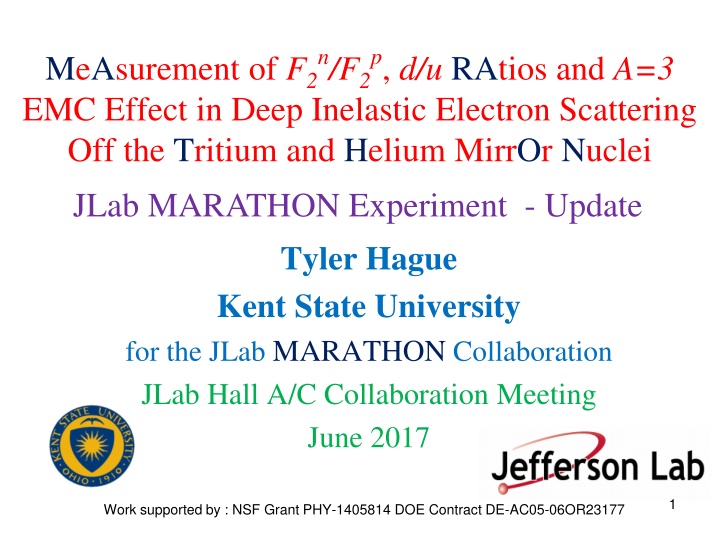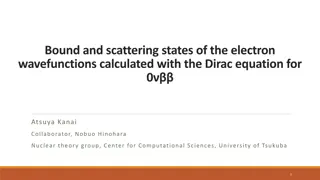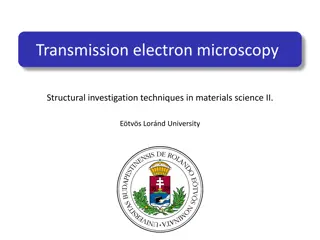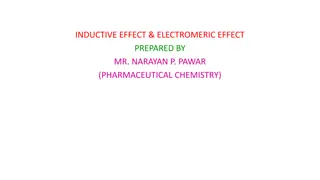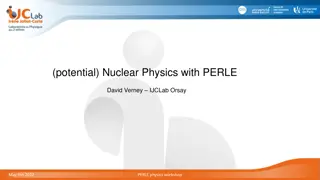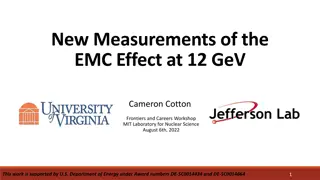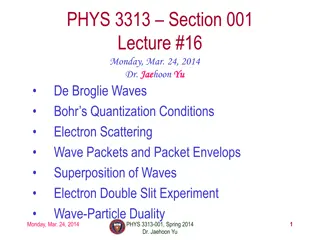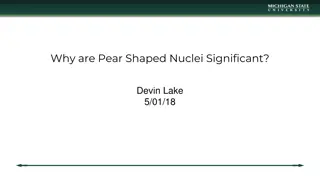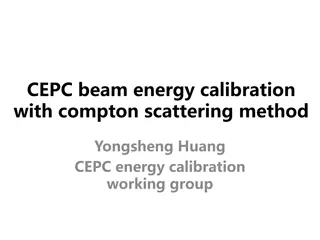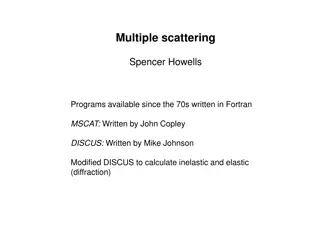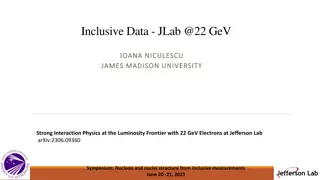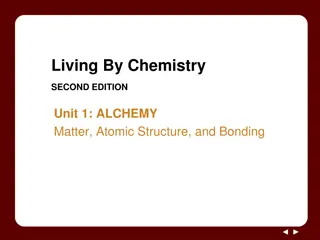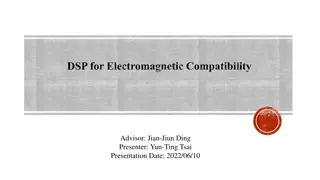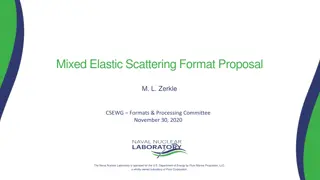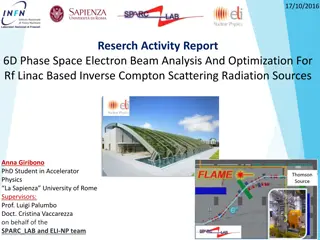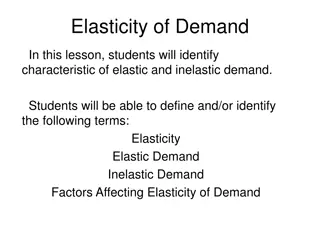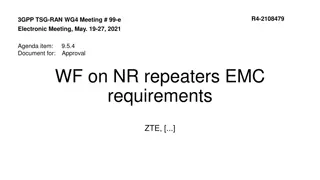Measurement of F2 EMC Effect in Deep Inelastic Electron Scattering Off Nuclei
MARATHON experiment at JLab aims to measure cross-section ratio of deep inelastic electron scattering from 3H and 3He mirror nuclei to determine ratios of structure functions and proton quark distribution functions using novel methods. The experiment will also explore the EMC effect for A=3 nuclei, important for understanding nuclear structure. Various theoretical models and experimental data from SLAC and other institutions are discussed in relation to nucleon structure and quark parton models in deep inelastic scattering.
Download Presentation

Please find below an Image/Link to download the presentation.
The content on the website is provided AS IS for your information and personal use only. It may not be sold, licensed, or shared on other websites without obtaining consent from the author.If you encounter any issues during the download, it is possible that the publisher has removed the file from their server.
You are allowed to download the files provided on this website for personal or commercial use, subject to the condition that they are used lawfully. All files are the property of their respective owners.
The content on the website is provided AS IS for your information and personal use only. It may not be sold, licensed, or shared on other websites without obtaining consent from the author.
E N D
Presentation Transcript
n/F2 p, d/u RAtios and A=3 MeAsurement of F2 EMC Effect in Deep Inelastic Electron Scattering Off the Tritium and Helium MirrOr Nuclei JLab MARATHON Experiment - Update Tyler Hague Kent State University for the JLab MARATHON Collaboration JLab Hall A/C Collaboration Meeting June 2017 1 Work supported by : NSF Grant PHY-1405814 DOE Contract DE-AC05-06OR23177
Overview and Goals of the Experiment MARATHON will measure the cross section ratio of deep inelastic electron scattering from the 3H and 3He mirror nuclei using the Hall A two HRS system of JLab. The ratio will determine the ratio of the neutron to proton structure functions (F2n / F2p)and the ratio of the proton quark distribution functions (d/u) using a new novel method that exploits the isospin symmetry of the A=3 nuclei. Experiment will also measure the EMC effect for 3H and 3He. A=3 EMC data are considered crucial for the effect understanding. 2
n/ F2 p, d/u Ratios and A1 Limits for x 1 F2 n p n/F2 p d/u A1 A1 F2 SU(6) 2/3 1/2 0 5/9 1/4 0 1 1 Diquark/Feynman 1/4 0 1 1 Quark Model/Isgur 3/7 1/5 1 1 Perturbative QCD 3/7 1/5 1 1 Quark Counting Rules A1: Asymmetry measured with polarized electrons and nucleons. QPM probability that the quark spins are aligned with the nucleon spin. A1 DESY and JLab (6 GeV and 12 GeV Programs) p, A1 n: Extensive experimental programs at CERN, SLAC, 3
SLAC 1968-1972 Friedman, Kendall, Taylor Nobel 1991 n/F2 pextracted from p and d DIS F2 using a Fermi-smearing model and a non-relativistic N-N potential Data in disagreement with SU(6) prediction: 2/3=0.67! High momentum quarks in p(n) are u(d) valence quarks There are no high momentum strange quarks in p and n Sea quarks dominate at small x Data consistent with di-quark model by Feynman and others 4
Nucleon F2Ratio Extraction Revisited SLAC DIS Data Whitlow: Assumes EMC effect in deuteron (Frankfurt and Strikman data-based Density Model) Melnitchouk &Thomas: Relativistic convolution model with empirical binding effects Bodek: Non-relativistic Fermi-smearing-only model with Paris N-N potential 5
Deep Inelastic Scattering and Quark Parton Model DIS cross section - Nucleon structure functions F1 and F2: = 2 sin 4 ' E dE d 2 2 Q F T d ( ( M 2 2 2 , ) 2 , ) F Q F Q ( ) 2 ( ) + 2 2 cos sin 2 1 ( ) M F 2 2 4 = E v ' E = = + 1 1 R L 2 = 2 2 4 sin ( ) 2 / Q E E 1 QPM interpretation in terms of quark momentum probability distributions qi(x) (large Q2and , fixed x): 1 ) ( 1 x q e x F i i = 2 i = 2 i ( ) ( ) F x x e q x ( ) 2 i 2 i Bjorken x: fraction of nucleon momentum carried by struck quark: x = 2 / 2 Q M 6
Nucleon F2Ratio Extraction from 3He/3H Just perform DIS from 3He and 3H. Binding of nucleons in the two nuclei is of same nature. Differences between bound and free nucleons in the two nuclei is calculable, summarized, for their ratio, by some parameter R* If R= L/ Tis the same for 3He and 3H, measured DIS cross section ratio must be equal to the F2 structure function ratio as calculated using R*: He He F 2 3 3 = 3 3 + p n 2 F F = 2 2 R + p n 2 F F H H F 2 2 2 Determine nucleon F2ratio using A=3 DIS cross sectiondata and R*( 1) from theory: F p 2 3 3 n He H 2 / R F / F = 2 2 2 3 3 F He H 2 F F R 2 2 7
R* has been calculated by three expert groups to deviate from 1 only up to ~1.5% taking into account all possible effects: * I. Afnan et al., Phys. Lett. B493, 36 (2000); Phys. Rev. C68, 035201 (2003) * E. Pace, G Salme, S. Scopetta, A. Kievsky, Phys. Rev. C64, 055203 (2001) * M. Sargsian, S. Simula, M. Strikman, Phys. Rev. C66, 024001 (2002) The new data will be almost free of nuclear structure theoretical uncertaintiesthat dominate the previous SLAC data, extracted from proton and deuteron deep inelastic scattering (DIS) measurements 8
A dependence EMC Effect Nucleon momentum probability distributions in nuclei is different from those in deuterium. Effect increases with mass number A. No universally accepted theory for the effect explanation. A=3 data will be pivotal for understanding the EMC effect. Ratio of EMC effect for 3H and 3He is the best quantity for quantitative check of the theory, free of most uncertainties. SLAC E-139, 1984 J. Gomez et al. 9
Experimental Plan and Requirements (I) After a successful spring 2010 target safety and design review, 3He/3H Hall A MARATHON proposal was fully approved in January 2011 to run for 42 days @100% efficiency. Proposal was based on the Left High Resolution Spectrometer (HRS) for low-x measurements and the Big Bite Spectrometer (BBS) for high-x measurements. Kent State students worked with Hall A staff and other students, starting in the summer of 2014, on the refurbishment and reassembly of the BBS detectors, electronics and data acquisition systems Change of plans after successful final target safety review that took place in the fall of 2015! 10
Experimental Plan and Requirements (II) For safety reasons, the target review committee had to impose: i) severe restrictions in the BBS movement (change of angle) and ii) limitations in accessing the BBS components and detectors for checkout and repair purposes. Access from the front was to be totally forbidden! MARATHON requested from the Lab to take the data with both the HRS spectrometers (instead of the Left HRS and BBS) at the expense of i) eliminating a highest-x point (x=0.87) in the resonance region and ii) reducing the W2 value of the highest-x DIS point (x=0.83) from 4.0 to about 3.5 GeV2. Request has been approved! HRS systems have been successfully used to complete the DVCS, GMP, and Ar40 experiments. 11
Experimental Plan and Requirements (III) Beam: Unpolarized electron beam with the highest energy available (11 GeV). Beam current will be limited to 20 A for target safety reasons. Target:Ladder structure will have helium, tritium, deuterium, and hydrogen high pressure cells [25 cm long, 1.25 cm diameter, 14 atm (3H), 30 atm (1H, 2H, 3He)] . DetectorPackages: Experiment will use the existing detector packages of the HRS systems (will operate in angular range between 15o and 60o, and in momentum range between 0.5 and 4.0 GeV.), and standard Hall A data acquisition and online analysis and monitoring software. 12
pand d/u Ratios n/F2 Projected JLab Hall A Data for F2 11 GeV beam; Left and Right High Resolution Hall A Spectrometers 3H and 3He gas target system; 42 days of data taking 13
EMC Effect for A=3 Mirror Nuclei Hall A data on 3H, 3He will be of similar precision to Hall C data 14
Summary JLab Hall A MARATHON experiment target system has passed safety review and is currently being installed. Experiment passed recently readiness review. Will use the two HRS electron detection systems. Is scheduled to take data in the fall of 2017. Will provide doctoral thesis topics for several graduate students. Will provide data on F2 theoretical uncertainties, and input for parton distribution parametrizations. Will provide precision data on the EMC effect for the A=3 nuclear systems n/F2 p and d/u with minimal 15
An Aside Searching for the source of BPM problems seen during the Ar40 experiment 16
What are we seeing? Vertical BPM does not look as it should from good beam and rastering Horizontal BPM correct shape Vertical BPM incorrect shape 17
What does this mean? Normally should see one diamond because of the phase lag. This looks like two overlapped diamonds When the raster is off, we see what appears to be a vertical jump in the beam 18
Can we find the frequency of the jump? Looking at a large number of events, there does not appear to be any structure If we zoom in to view a small number of events, we don t see any structure 19
Can we find the frequency of the jump? Looking at a large number of events, there does not appear to be any structure If we zoom in to view a small number of events, there does not appear to be any structure If there is a frequency, it is faster than the clock trigger and we can t see it 20
Is the beam really jumping? The harp scan plot is inconsistent with the beam jumping Vertical component of reconstructed track at HRS focal plane inconsistent with beam jumping 21
Is the beam really jumping? The harp scan plot is inconsistent with the beam jumping Vertical component of reconstructed track at HRS focal plane inconsistent with beam jumping We don t see the beam jumping before or after the BPM 22
Thank You 23
R=L/TMeasurements SLAC/CERN data show that the ratio R= L/ Tis the same for all nuclei within experimental errors 3He/3H JLab data will be of better precision than SLAC data [wider angular range!] 24
EMC Effect Nuclear F2structure function per nucleon is different than that of deuterium: large dependence on Bjorken x and mass A. Quark distribution functions modified in the nuclear medium. Possible explanations include: Binding effects beyond nucleon Fermi motion Enhancement of pion field with increasing A Influence of possible multi-quark clusters Change in the quark confinement scale in nuclei Local environment and density dependence No universally accepted theory for the effect explanation. A=3 data will be pivotal for understanding the EMC effect. Theorists: Ratio of EMC effect for 3H and 3He is the best quantity for quantitative check of the theory, free of most uncertainties. 25
Deep Inelastic Scattering and Quark Parton Model Nucleon Quark Parton Model (QPM): electron scatters from the Gell-Mann/Zweig quarks interacting through massless gluons. Related formalism holds in a frame where the target moves with infinite momentum. In the Bjorken scaling/Deep Inelastic Scattering (DIS) limit (large Q2and , with fixed x), the structure functions depend only on the Bjorken scaling variable x = Q2/2M , the fraction of the nucleon momentum carried by the struck quark. Interpretation of structure functions in terms of quark probability momentum distributions qi(x) (up, down and strange quark and antiquarks) and quark electric charges ei: 1 ) ( 1 x q e x F i i = 2 i = 2 i ( ) ( ) F x x e q x ( ) 2 i 2 i 26
n/F2 p in Quark Parton Model F2 Assume isospin symmetry: ) ( x u p n p n ( ) ( ) ( ) ( ) ( ) d x u x u x d x u x p n p n ( ) ( ) ( ) ( ) ( ) ( ) d x u x d x d x u x d x p n p n ( ) ( ) ( ) ( ) ( ) ( ) s x s x s x s x s x s x Proton and neutron structure functions: 4 1 1 = + + + + + p ( ) ( ) ( ) F x u u d d s s 2 9 9 9 4 1 1 = + + + + + n ( ) ( ) ( ) F x d d u u s s 2 9 9 9 Nachtmann inequality: nF p / 1 4 / 4 F 2 2 27
SLAC/CERN Data Interpretation in QPM Nachtmann inequality satisfied: nF p / 1 4 / 4 F 2 2 n/F2 p 1: Sea quarks dominate with: + = + = + For x 0 : F2 u u d d s s n/F2 p 1/4: High momentum partons For x 1 : F2 in proton (neutron) are up (down) quarks, and: + s = 0 s For medium and high x, safe to assume that (with d and u denoting now quark plus antiquark distributions): + n 1 [ ( 4 + / )] F d u = 2 p 4 [ ( / )] F d u 28 2
pDeuteron Extraction Uncertainties Theoretically, F2d is a convolution of the freenucleon F2 Uncertainty in knowledge of the nucleon-nucleon potential introduces a large uncertainty in the determi- nation of F2 Realistic relativistic calculations also show a large sensi- tivityin the F2 in the deuteron (W. Melnitchouk and A. Thomas). Existence of an EMC effect in the deuteron (if the nucleon qi(x)in the deuteron are different than those of the free nucleon) would alter significantly the extracted F2 of the EMC effect in the deuteron! n/ F2 F2 pand F2 n functions with the deuteron wave function. n (and F2 n/F2 p). n extraction on the nucleon binding effects n value. Note: recent JLab data support the existence 29
n/F2 p from Standard analysis of F2 proton and deuteron data shows large uncertainty at high-x values depending on nucleon-nucleon potential used. 30
Theory Overview (I) SU(6)-breaking Diquark Model (Close/Feynman, 1970 s) Phenomenological explanation: fall off of F2 limit easily explainable using SU(6) nucleon wave function (Close, 1973) or Regge theory (Feynman, 1975) and assuming that the spectator diquark configuration with total spin s=1 is suppressed relative to that with s=0. Limit at x=1 in agreement with the SLAC/CERN data. Constituent Quark Model (Isgur and Carl, 1980-2000) Suppression fully understood in the hyperfine-perturbed quark model: color-magnetic hyperfine interaction generated by gluon exchange is proportional to quark spin dot products si sj. Force is repulsive(attractive) for parallel(antiparallel) spins and allows the u(x) and d(x) quark momentum distributions to be different. Limit for x=1 in agreement with the diquark model and data. n/F2 p and its x=1 31
Theory Overview (II) Perturbative QCD (Farrar and Jackson, 1975) Simple consideration of isospin and helicity structure of nucleon s quark wave function within perturbative QCD dictates that for diquark spin alignment (s=1) only exchange of longitudinal gluons is permitted, resulting in suppression of Compton scattering amplitude, which causes the F2 Problem: pQCD x=1 limit different than that of quark/diquark model! QCD Counting Rules (Brodsky et al., 1995) Early pQCD findings substantiated within first-principles calcu- lations of Counting Rules of QCD predicting the high-x behavior of quark distributions: q(x)~(1-x)2n-1+2 h, where n is the minimum number of not interacting (spectator) quarks and h is the difference in helicity between the struck quark and the nucleon. Same x=1 limit as pQCD. n/F2 p fall off. 32
The Tritium Target System Five-cell target structure (1H, 2H, 3H, 3He, Al Dummy): All cells: 25 cm long, 1.25 cm diameter, 20 A max current 3H cell: 10 atm, 1100 Ci activity 1H, 2H, 3He cells: 25 atm Cells will be filled at the Oak Ridge National Laboratory. Target will be shipped to JLab using commercial services. System will be enclosed in secondary sealed containment vessel (no reliance on fast valves). A catastrophic leak will be vented through stack above Hall A. Resulting emission will keep tritium levels at the JLab site boundary below regulatory limits. Tritium target project has passes a safety review. 33
Electron-Nucleus Inelastic Scattering Cross section for inelastic electron-nucleus scattering [E (E ): incident (scattered) electron energy, : electron scattering angle, M: nuclear mass] in terms of nuclear F1 and F2 structure functions: = 2 sin 4 ' E dE d Q F ( ) 2 ( ) d ( ( M 2 2 2 , ) 2 , ) F Q F Q + 2 2 cos sin 2 1 ( ) 2 2 4 4 = E sin E E = ' E 2 F M v = + 1 1 2 R 2 2 ( ) 2 / Q 2 1 Ratio R has been measured to be the same for proton, deuteron and all other nuclear targets. Cross section ratio for two nuclei, say 3H and 3He, becomes equal to ratio of their F2 structure functions. 3 ( ) 3 ( ) d H d He ) / = 3 ( 2 F / ) 3 ( 2 F H He ' ' d dE d dE 34
3He and 3H Structure Functions Nucleon structure function in nucleus A in the Impulse Approximation: extension of deuteron model (Melnitchouk and Thomas): f dy x F 2 [ ) ( = NA N N ( )] ( / ) y F x y f F / 2 / 2 N A N A For 3He: 3 = + He p n 2 F f F f F 2 2 2 3 3 / / p He n He With isospin symmetry: = f f f p 3 3 / / n H p He = f f f n 3 3 / / p H n He Then for 3H: 3 = + H p n 2 F f F f F 2 2 2 n p Charge symmetry breaking effects are small! 35
